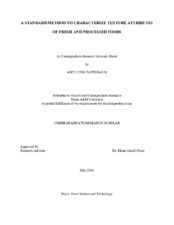| dc.description.abstract | This study focused on the development of a standard method for characterizing the texture attributes of fresh and processed foods. Currently, there is no standard method that can be used to determine textural attributes among a diversity of food products. The method developed will be based on the measurement of well-defined mechanical and rheological properties and should be reproducible, instrument-independent, and correlate well with sensory analyses. A variety of fresh and processed foods for which texture is critical to the quality of the food were tested. Two instruments were used in this study to determine the reproducibility of a standard method: a TA-TX2 Food Texture Analyzer (Texture Technologies, NY) and a Brookfield CT3 Texture Analyzer (Model CT3-100, Brookfield Engineering Laboratories, MA). A fresh food product (cherry tomato) and a processed food product (marshmallow) were selected for this study due to their well-defined geometric shapes and dimensions that reduced variability due to sample size variations. Compression, puncture, and Texture Profile Analysis (TPA) tests were performed to determine if the results were instrument-dependent. In the compression test, Young’s modulus, yield strength, and ultimate strength were calculated for the marshmallows. All the food mechanical properties were not significantly different (p<0.001). In the puncture testing on the cherry tomatoes, Young’s modulus, yield strength, and ultimate strength were also calculated without significant differences (p<1000) between the instruments. A TPA test was run on both the marshmallows and cherry tomatoes and several textural properties were calculated from each force-time curve. For the marshmallows, hardness1, hardness2, and springiness were measured . When comparing the results between the TA-TX2 and Brookfield CT3, these properties were not significantly different (p<0.001). In the cherry tomato TPA testing, only hardness1 and hardness2 were calculated due to time constraints. Both hardness1 and hardness2 from both instruments were found to not be significantly different (p<0.001), but further testing is recommended to measure other textural properties using the TPA method. For compression, puncture, and TPA testing, it was proven that both instruments, the TA-TX2 and Brookfield CT3, will yield the same results. Users of textural instruments can rely upon data from either analyzer and trust that the results would not be significantly different. | en |


